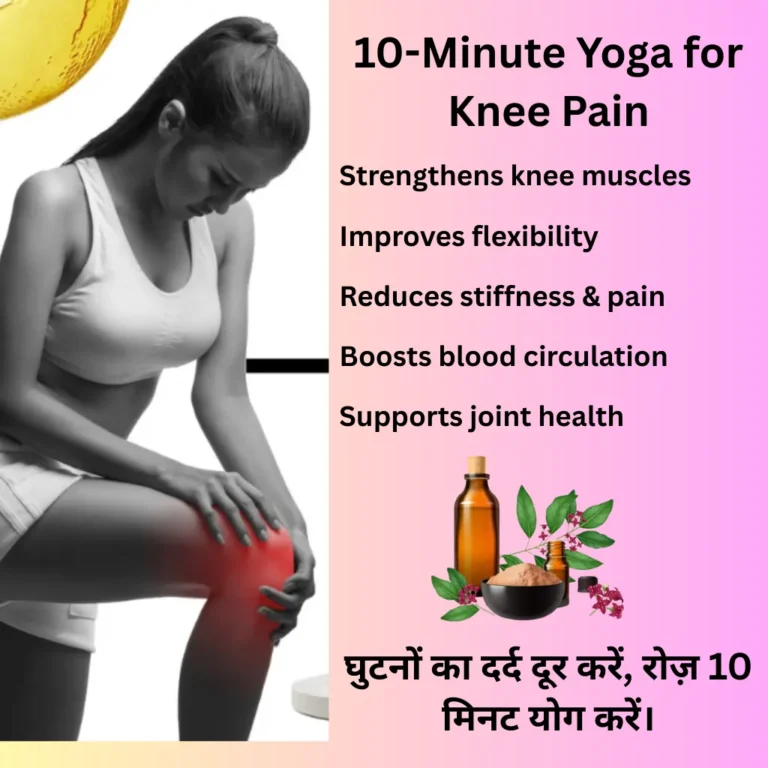10-Minute Yoga for Knee Pain: Simple Routine to Strengthen and Heal Naturally
When knee pain starts interfering with your daily activities—whether it’s walking, climbing stairs, or simply sitting for long hours—it can feel frustrating and limiting. Many people immediately think of painkillers or surgery, but there are natural, effective ways to strengthen your knees and reduce discomfort. One such gentle yet powerful solution is 10-minute yoga for knee pain. Practicing yoga daily for just 10 minutes can improve flexibility, reduce stiffness, strengthen muscles around the knees, and even calm inflammation.
In Ayurveda, knee pain is often linked to Vata imbalance (dryness, stiffness, and degeneration of joints). Yoga, when combined with Ayurvedic lifestyle changes, becomes a holistic therapy—healing not just the knees, but also improving balance, posture, and overall joint health.
In this guide, we’ll explore the causes of knee pain, an easy-to-follow 10-minute yoga routine, Ayurvedic remedies, and expert tips to make your knees stronger and healthier.
In this article, we’ll explore:
-
The Ayurvedic view on knee pain
-
A 10-minute yoga sequence designed for knee pain relief
-
Benefits of each pose
-
Precautions and modifications
-
Ayurvedic remedies, herbs, and oils that support knee health
-
FAQs about yoga for knee pain
Ayurvedic Perspective on Knee Pain
In Ayurveda, knee pain is often understood as a manifestation of Vata dosha imbalance. Vata is the energy that controls movement, circulation, and dryness in the body. When Vata becomes aggravated due to factors like aging, irregular lifestyle, poor diet, or excessive strain on the joints, it accumulates in the bones and joints. This leads to dryness, stiffness, cracking sounds, and pain—classic signs of a condition known as Sandhivata (Ayurvedic term for osteoarthritis).
Common symptoms of Vata-related knee pain include:
-
Stiffness in the knee joints, especially in the morning or after rest
-
Cracking or popping sounds while bending or walking
-
Weakness and instability in the legs
-
Dryness and roughness around the joints
-
Pain that worsens with cold, wind, or overexertion
According to Ayurveda, the solution is not limited to external treatments like oils or massages. True healing comes from restoring internal balance. This includes:
-
Proper diet – Warm, nourishing, Vata-pacifying foods like ghee, soups, cooked vegetables, and herbal teas.
-
Herbal remedies – Ayurvedic herbs such as Ashwagandha, Guggulu, Shallaki (Boswellia), and Turmeric to reduce inflammation and strengthen joints.
-
Daily yoga & movement – Gentle practices like 10-minute yoga for knee pain, pranayama, and regular walking to keep joints flexible and maintain circulation.
-
Abhyanga (oil massage) – Applying warm medicated oils like Mahanarayan Taila or Sesame oil to the knees helps reduce stiffness and nourish tissues.
By combining these practices, Ayurveda not only reduces pain but also addresses the root cause of knee degeneration.
10-Minute Yoga Routine for Knee Pain Relief
If you are struggling with stiffness, swelling, or discomfort, this 10-minute yoga for knee pain routine can help strengthen the joints, improve flexibility, and reduce pain naturally. The sequence is gentle, beginner-friendly, and safe for daily practice at home.
1. Ankle-to-Knee Warm-up (1 Minute)
-
Sit on a chair or yoga mat.
-
Slowly rotate your ankles clockwise and counter-clockwise.
-
Gently bend and straighten your knees.
Why: Improves blood circulation, warms up the knee joints, and prepares them for movement.
2. Supported Butterfly Pose (Baddha Konasana – 2 Minutes)
-
Sit on the floor with feet together, knees bent outward.
-
Keep a cushion or folded blanket under your knees for support.
-
Slowly flap your knees up and down like butterfly wings.
Why: Opens up hip and knee joints, releases stiffness, and increases flexibility.
3. Half Leg Stretch (Ardha Pawanmuktasana – 2 Minutes)
-
Lie on your back.
-
Gently pull your right knee towards your chest while keeping the other leg straight.
-
Hold for 20–30 seconds, then switch sides.
Why: Strengthens thigh muscles, reduces knee strain, and relieves tension in joints.
4. Low Lunge Stretch (Anjaneyasana – 2 Minutes)
-
Step one leg forward into a low lunge position, keeping the back knee on the floor.
-
Place hands on the front thigh or yoga blocks for support.
-
Hold and breathe deeply for 30 seconds on each side.
Why: Stretches quadriceps and hip flexors, reducing pressure on the knees.
5. Supported Chair Pose (Utkatasana Variation – 2 Minutes)
-
Stand with feet hip-width apart.
-
Bend your knees slightly as if sitting on an invisible chair.
-
Keep a wall or chair behind you for support.
Why: Strengthens thigh muscles, supports knee stability, and improves posture.
6. Relaxation in Corpse Pose (Shavasana – 1 Minute)
-
Lie down comfortably on your back.
-
Keep legs slightly apart and arms relaxed at your sides.
-
Close your eyes, breathe deeply, and release all tension.
Why: Relaxes muscles, calms the nervous system, and allows healing energy to flow.
With just 10 minutes of daily practice, this yoga routine can naturally support knee strength, reduce stiffness, and improve flexibility over time. Ayurveda recommends combining yoga with proper diet, herbal remedies, and oil massage for long-lasting results.
Benefits of 10-Minute Yoga for Knee Pain
-
Strengthens supporting muscles around the knees for better stability.
-
Improves flexibility & circulation, keeping joints active and healthy.
-
Reduces stiffness and chronic knee pain naturally over time.
-
Supports joint lubrication for smoother, pain-free movement.
-
Relieves stress and tension, which often make knee pain worse.
Safety Tips & Modifications
-
Avoid deep squats or high-impact poses.
-
Use a yoga block, cushion, or chair if needed.
-
Move slowly and never force the stretch.
-
Stop immediately if you feel sharp pain.
Ayurvedic Remedies for Knee Pain
Along with yoga, Ayurveda suggests remedies to heal joints naturally:
1. Herbs
-
Ashwagandha – reduces inflammation
-
Shallaki (Boswellia) – supports joint mobility
-
Guggulu – strengthens bones and joints
2. Oils for Abhyanga (Massage)
-
Mahanarayan Oil
-
Dhanwantharam Oil
-
Sesame Oil (Til Taila)
3. Diet Tips
-
Warm, easy-to-digest foods
-
Ghee and turmeric for lubrication and healing
-
Avoid cold, dry, and processed foods
FAQs About Yoga for Knee Pain
Bridge pose, Warrior II, and gentle stretches are best.
Yoga cannot fully cure arthritis, but it helps reduce pain, improve mobility, and delay progression.
Avoid deep squats, Vajrasana (sitting on heels), and fast movements.
Daily practice of 10–15 minutes is recommended for long-term benefits.
Yes, Ayurveda uses herbs, oils, diet, and Panchakarma therapies to balance doshas and relieve joint pain.
Conclusion
Knee pain can stop you from living your best life, but with Ayurveda and Yoga, you don’t have to rely on temporary painkillers. A simple 10-minute yoga for knee pain routine, combined with Ayurvedic herbs and oils, can strengthen your knees, restore flexibility, and improve quality of life.
Start small. Dedicate just 10 minutes daily, and within weeks, you’ll notice a difference.
For personalized Ayurvedic guidance and herbal remedies for knee pain, visit Devkalp Ayurveda today.
Ayurvedic Doctor | 15+ Years Experience | General Physician and Panchakarma Specialist
Dr. Dinesh Kumar is a qualified Ayurvedic doctor with over 15 years of experience in holistic physician and Panchakarma therapies. He specializes in natural treatments for skin, orthopedic, and lifestyle-related issues.
Clinic: Devkalp Ayurveda | Website: devkalpayurveda.com



